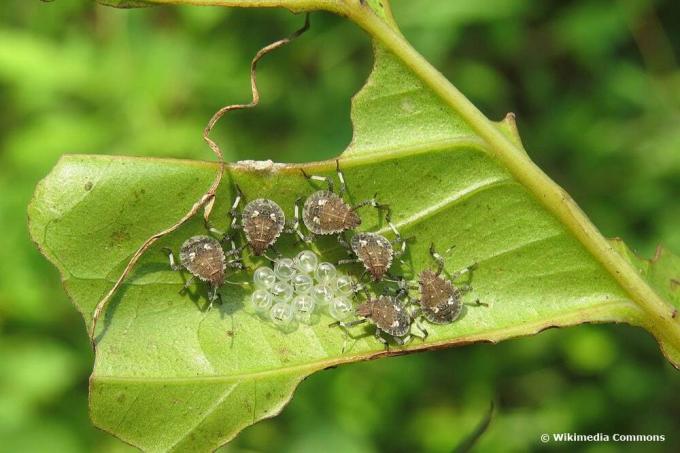
table of contents
- Bedbugs - a brief overview
- Common types of bedbugs in the home
- The birch bug (Kleidocerys resedae)
- The linden bug (Oxycarenus lavaterae)
- The American pine bug (Leptoglossus occidentalis)
- The green resp. brown stink bug (Pentatomidae)
- frequently asked Questions
In order to successfully combat bed bugs in the home, it is important to know what type it is. This guide introduces the most common types and gives tips on treatment.
In a nutshell
- Family: Heteroptera
- different subspecies
- four species are particularly common in the house
- feel drawn to light and warmth
- Bedbugs are not dangerous
Bedbugs - a brief overview
The bug occurs in many different species in Europe. Most colonize trees, especially their bark, or live in high grass on floodplains, meadows and fields. These varieties only get lost in houses and apartments by chance. Others prefer warm living spaces and do not shy away from being close to people when looking for a place to spend the winter. Four species in particular are known to move into apartments in autumn:
Common types of bedbugs in the home
The birch bug (Kleidocerys resedae)
The birch bug is a bug from the family of the ground bugs (Lygaeidae). It is divided into three subspecies, which are very similar in their way of life. Superficially, the insects are staying Birch trees on. Their smell and the cricket-like chirping can be heard from afar. When the days get cooler, they look for wooden crevices and apartments in order to use the winter for reproduction. The larvae hatch in spring around the end of March and collect in large numbers in so-called schools on birch trees. There they feed on the sap, but die within a few days as soon as they are fully grown.
In the apartment, the bug comes out of its hiding place at room temperature and flies to light sources such as lamps or windows.

External features:
- broad, oval body
- reddish brown
- 4.5 to 6 mm long
- black resp. brown dot pits on the pronotum and head
- black transverse grooves on the body
- three points arranged in a row on the half-ceilings
- bright, glass-like fore wings
- four-part feeler
- red, short legs
Note: The birch bug not only nests in the trees of the same name, but also feels at home in herbaceous plants, for example. Anyone who cultivates such plants on the balcony or as a houseplant should be particularly careful in autumn.
The linden bug (Oxycarenus lavaterae)
The linden bug, also known as the mallow bug, is widespread in North Africa. Further north there is only one specific variety of this species. The bug nests in native shrubs such as the hibiscus, poplar or yew trees. In autumn they move from said plants to linden trees, where they form immense colonies.

External features:
- Females 5.5 mm to 6 mm long
- Males 4.7 mm to 5.1 mm long
- red black colored body
- Head, legs and limbs completely black
- Legs a little brightened
- Ears and abdomen brick-red
- red brown back with three rows of dots
- colorless fore wings with a white sheen
- Red head and abdomen nymphs
The American pine bug (Leptoglossus occidentalis)
The American pine bug is a bug from the family of the edge bugs (Coreidae). In this country it is also known as the cone bug. It was given this name because of its ability to suckle on the cones of various conifers. While the extent of the resulting damage is relatively minor in Europe, the insect destroys entire conifer plantations in America and is therefore a feared pest.
The cone bug forms only one generation per season. If you don't look closely, you may mistake the insect for a bumblebee, as it is very similar to this in terms of its flight characteristics and the clearly audible hum. Once a male has discovered a suitable roost, it secretes a scent, a so-called aggregation pheromone, which it uses to draw the attention of its conspecifics to the shelter.

Note: In contrast to most types of bedbugs, which give off an unpleasant odor, the fragrances of this species are reminiscent of the scent of an apple.
External features:
- 15 mm to 20 mm long
- 5 mm to 7 mm wide
- long antennae
- reddish brown to black body
- white, narrow zigzag band on the back
- yellow or orange wings with black veins
The green resp. brown stink bug (Pentatomidae)
The stink bug is one of the most species-rich insects there is. More than 6,000 subspecies are known so far. Unfortunately, many of them are considered pests, which as sap suckers cause great losses in agriculture. In addition, they are now resistant to certain pesticides. Stink bugs have large wings that make them excellent fliers.

External features:
- shield-shaped body
- large label, often covers the whole body
- strikingly colorful depending on the species
- Body color adapts to the season
frequently asked Questions
Chemicals should never be used to control a bedbug. The animal doesn't have to die anyway. It is best for those affected to catch the intruder with a glass and expose him to the open air. So that the animals do not even get into the house, all joints and cracks should be sealed with silicone. Fly screens can also help.
Contrary to their reputation, bedbugs are not an indication of poor hygiene. The insects are simply looking for a warm winter place and are attracted to lighted, heated rooms. So if you ventilate again in the evening, you should definitely turn off the light, as long as there are no mosquito screens in front of the window.
Bedbugs are completely harmless. When crushed, however, they give off a foul smelling secretion.


